The following analysis for ‘large residential developments’ provides the basics to determining actual quantities of varying sized dwelling units which includes both owner occupied and rentals, as well as low, moderate and high-end units. This program development is done to create a development which reinforces the fundamental composition of a vibrant community, an important part of any neighborhood. The analysis, based on population quantities and age groups, creates a prototype model which can be applied to future residential developments. It also accommodates a small percentage of affordable housing which can be provided at little or no cost, thus responding to a growing social need and proving itself worthy, in all respects, to being an integral part of a community.
The community, both physical and psychological, wishes to achieve the feeling of an extended family, in which all its inhabitants are respected and welcomed, ensuring that no person shall be brushed away as not worthy. It is a community which embraces variety both physically (in the physical form and detail) and in its spirit, for it is variety that provide the foundation for a thriving, energetic, vibrant place. The result in all aspects reflects the best of social living.
The resulting development, containing between 300 and 1500 units, plays its part of a larger city block and street/city scape, incorporating the spirit of surrounding context and enhancing its place with connections to other parts of the city, establishing its place within the larger community. The resulting design, much like the Boston ‘Tent City’ residential development which I designed, consists of a combination of low and mid-rise structures. And for this study I take the best of what I design there, both physically and programmatically, pushing that design technology forward using data from a variety of sources to support the resulting conclusions.
This is Part 1 of an unknown series of examinations into creating the perfect urban residential development. One that is self-sustaining, environmentally friendly and inclusive. It hope to establish basics of program, reinforcing things all humans need to feel like they are home, welcomed, secured and proud of their habitation.
The following is a series of analysis that must be merged into one complete design. This is the work of a qualified designer to do the conclusion justice and involves a lot more than just choosing the right sized windows and picking colors. To complete a real project requires integration of a substantial host of elements including program, structures, circulation, hierarchies, etc. Tent City is an excellent example of this and I could go on about my design for this project, from the parking garage structure and elevation impacting the entire project, like how the dwelling unit dimensions, the egress and the parking spaces all align to help make the entire project inherently affordable, to the elevation of the parking level to correspond to a ramp that didn’t remove parking spaces while elevating the 1st floor, which resulted in two roads that slope gently upward to the higher elevation and doing so over parking spaces below so that they remained usable, and, a plaza that connects the outer street elevation with the inner court elevation to provide handicap accessibility without the need for handicap ramps. If you comprehended all of that you are beginning to understanding the true complexity of being a qualified architect and designer.
As mentioned, this analysis is broken up into interrelating parts that draw sub-conclusions with regards to dwelling and other program quantities and types. It all starts with the simple square foot and understanding what percentage of cost is dedicated the cost of construction, what percentage is dedicated to profit and what are the maintenance costs to continue to operate the building(s) in new condition. Diagram A breaks down the basics of these costs.
Note that affordable housing and market rate housing is priced, at this stage, identically as the expected habitable result will be the same as other units, no distinction made. Eventually the cost of the affordable housing portion will be substantially reduced to make it affordable to low income individuals and families. This will be achieved by adjusting the profit margin of market rate housing and doing the same for some higher-end dwellings that have much greater profit margins, along with other program elements that support tenants and the community at large. Because the percentage of affordable housing is so low (of 95% market rate and high end units only 5% is affordable, as discussed below).
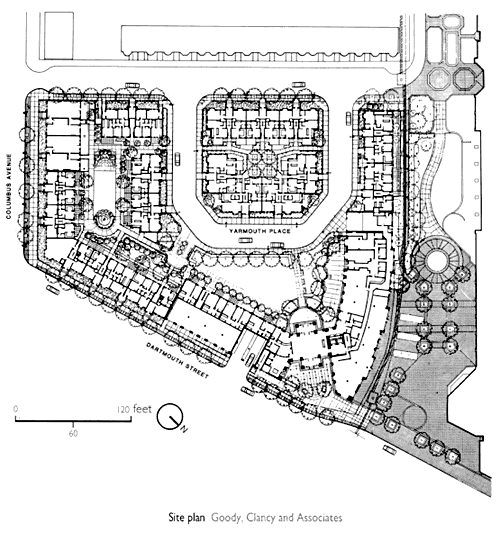
Above Tent City Residential Development design by Architect Nic Buccalo of SimpleTwig Architecture for Goody Clancy and Associates. This entire project was designed within one month, and included all unit plans for townhouses and their courtyards, rental apartments, rough 3d model, full-site parking garage, structure, circulation and other program elements including an on-site road.
“In the United States, 5.2 million American households use federal rental assistance to afford modest housing. 68% (or 3.5 million) are seniors, children or people with disabilities. 40% of people classified as low-income are homeless or pay over half their income for rent.” Source cbpp.org (Federal rental assistance fact sheets).
With 344 million Americans, 5.2 million represents 1.5% of all Americans (round up to 2%) need assistance. For our purposes we will achieve 5% units that are classified as affordable for low income individuals, to help compensate for the vast majority of dwellings that are market rate and to help undo how most low income housing is essentially segregation housing. This should be a requirement for all projects that provide 100 units or more.
Of the 20% ‘high-end’ units, there are actually a variety of unit types and sizes, and classifications of ‘low high-end, mid high-end and high high-end’. This spreads the risk out and makes for easier to sell units that help financially support the entire project. Ultimately this is also a factor of location and what can reasonably be supported given the growth of the neighborhood and city, and whether reasonable views and privacy can be attained for those willing to spend more.
Diagram C indicates what percentage of units are either owner-occupied or rental. Rental units are valuable as over time they provide ever increasing income to a development. As such they can be important to help offset maintenance costs while at the same time being an integral part of the community by providing units to those who need a rental. Why are there so many owner-occupied units? This is to ensure the continued maintenance of the development by people who care. ‘All rent buildings’ can easily fall on disrepair as landlords often hold the upper hand against tenants, and renters in general care less about maintenance since renting is often seen as temporary. Ultimately the percentages reflect what works in a healthy neighborhood like in Brooklyn, NY where most of the buildings are owned by people who live in the neighborhood, renting out a portion of their building for supplemental income. The concept is the same for large developments.
Diagram D provides the rest of the development program in general terms. The exact disposition of area quantities would have to be considered given the context and whether the site is considered a ‘linking thorough fare’ for vehicular, transit and/or pedestrian traffic and how certain program components would fare, understanding that their two main purposes are to 1) support the complex tenants and 2) become an integral part of the neighborhood.
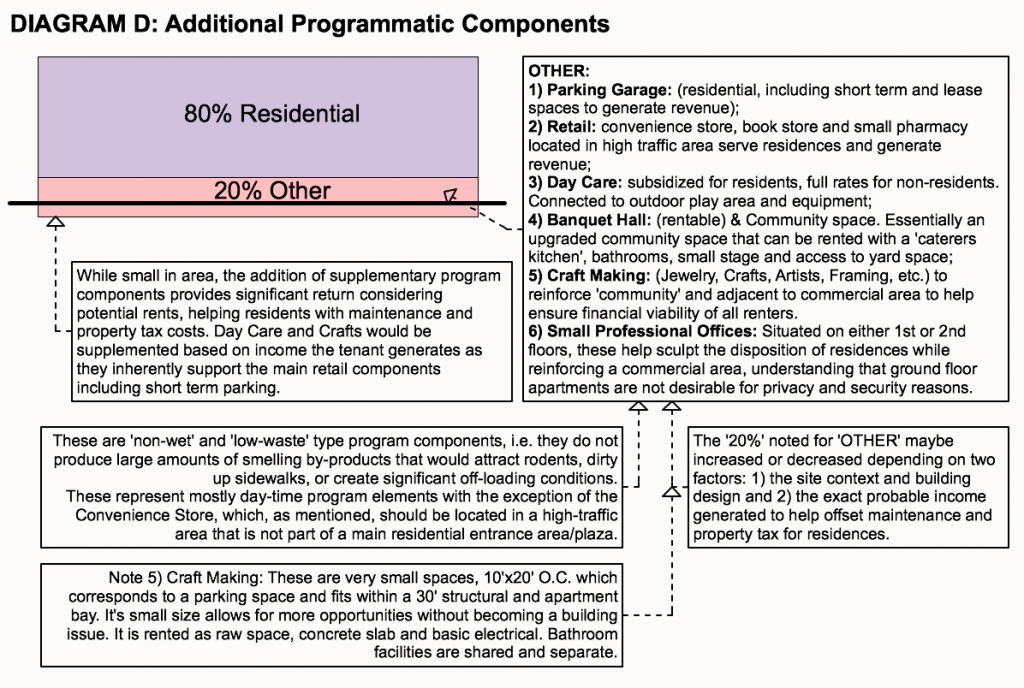
Also note that this is a further extension of my proposed program for Tent City in Boston, in which I proposed the addition of many extra program elements like a convenience store, a day care, laundry services, a community room, a play ground, courtyards, some private backyards, a ‘green’ and public garden and finally a plaza. These program components that while not part of our task was both accepted as necessary and have proved to be viable to the spirit and use of the development. For instance, the convenience store is still in business and doing quite well.
Above: Convenience Store at Tent City, called ‘City.’
As in Tent City, other programmatic elements could include a restaurant (Tent City has The Salty Pig which has interior and exterior plaza seating), a bank branch, an IT training school geared to young adults and children and other creative and commercial enterprises.
Next we will review actual dwelling unit types. In other parts of this extended article we will discuss the specific sizes and dispositions of the actual units, but for now we need to establish what types of units, and then in what percentages those units will be provided in order to create a community.
LARGE DEVELOPMENTS: APARTMENT TYPES:
Large block sized developments, containing anywhere from 350 to 1000 dwelling units, also contain other supporting program elements not discussed herein, but are essential to creating a successful sustaining community. As part of a rich vibrant neighborhood, the type of dwelling units themselves support the foundation for financial long-term success.
- Studio; Ideal unit has large living area with bed cove, separate small kitchen and bath, ample storage. 1 lavatory sink, walk-in shower, one piece toilet. Coat hook area at entry door. 4′ min. kitchen countertop area, modest refrigerator (2′ width). Use of laundry room to help keep cost of Studio low and encourage social interaction. It is imperative that this unit type has a bed nook capable of holding a full sized bed with side tables. People don’t want to sleep in their living room or kitchen, so this is a fundamental requirement. Also, size is important for psychological health so we are not referring to ‘tiny homes.’
- 1 Bedroom Unit; Ideal unit has moderate sized bedroom for couple with walk-in closet (6’x6′ min.), 1 lavatory sink, walk-in shower, one piece toilet, 2’x2′ min. coat closet, 5′ min. kitchen countertop area, modest refrigerator (2′ width). Use of laundry room to help keep cost low and encourage social interaction.
- 1.5 Bedroom Unit (extra home office/craft area); half bedroom attached to bedroom as a nook for potential nursery, has moderate sized bedroom for couple with walk-in closet (6’x6′ min.), 1 lavatory sink, walk-in shower, one piece toilet, 2’x2′ min. coat closet, slightly larger kitchen with 30″ refrigerator and at least 7′ countertop space. Use of laundry room with optional washer/dryer hookup available (tenant supplied applicances).
- 2 Bedroom Unit; Features to include a full bathtub/shower combination. 1 or 2 lavatories with ample countertop space and bathroom storage. Full side by side washer/dryer. 8′ countertop space min. with 30″ refrigerator.
- 2.5 Bedroom Unit (extra home office/craft area); 2 lavatories with ample countertop space and bathroom storage. Full side by side washer/dryer. 8′ countertop space min. with 30″ refrigerator.
- 3 Bedroom Unit; 2 lavatories with ample countertop space and bathroom storage. Full side by side washer/dryer assuming children. 10′ countertop space min. with probable island and 36″ refrigerator. Larger master suite and progressively smaller bedroom sizes. 6′ linear closets for smaller bedrooms min. 6’x8′ master walk-in closet with an addition linen/storage closet of 6 linear feet.
- 3.5 Bedroom Unit (extra home office/craft area); 2 lavatories with ample countertop space and bathroom storage. Full side by side washer/dryer assuming children. 10′ countertop space min. with probable island and 36″ refrigerator.
- 4 or more Bedroom Units:optional for medium priced units, a must for high-end owner-occupied units.
——————
NOTES:
Kitchens: All kitchens to have a min. of 1′ countertop space adjacent to the opening side of the refrigerator, on both flanks of the stove and sink. All sinks to have a minimum of a lever handle hot/cold hardware with pull out spray spout. All kitchens to have a built-in microwave oven. All kitchens to have a ‘vented to exterior’ hood (to prevent smells from degrading the quality of living for other tenants).
Bathrooms: All bathrooms to have linen/storage adjacent to or inside bathroom. All showers/tubs to have wall recess for shampoos. Toilet tissue holders to be wall recessed type. Sink facet to be goose neck type to provide room for washing hair, etc. All sink countertops to provide room for toiletries, including recessed medicine cabinet/mirror with vanity lighting. Exhaust vents (80 cfm quiet duct) to always be located above tub/shower.
General Storage: All units will have off-unit storage space available, to hold those things that are seasonal or non-home type stuff, like toys, tools, bikes, etc., i.e. the normal things that Americans have to store that would otherwise clog an urban apartment making it less habitable.
Windows: Windows will be situated to reflect maximum amount of light on side walls and if possible use of light shelves to reflect light onto ceilings. All top floor units will incorporate high efficiency skylights for light/ventilation.
Roofs/Terraces: All roofs will have accessible landscaped terrace(s) for residents use.
Outdoor Space: Modest recessed (not projecting balconies) will be provided for 30% of 1 bedroom units, 60% of 2 bedroom units and 30% of 3 bedroom units, along with public access to ‘backyard’ gardens and roof terrace(s).
Rental Apartments: All rental apartment to have only electric type stove tops and ovens. There shall be no use of natural gas. This will make the apartments safer from fire (considering the transition nature of the tenants) and provide what is considered a better heating delivery system. It will also make the apartments slightly cheaper to build as a gas line and gas meters will not have to be installed. Further, the stove top may be flush with the countertop surface with a separate oven, making better use of the limited countertop space and preventing debris from falling in between a stove appliance and cabinets as in conventional layouts.
Electrical Metering: While the electricity of the building will probably be paid through a central meter and via maintenance fee, each unit will have a sub-meter outside the apartment door, to provide tenants with actual usage and allow maintenance fees to reflect usage. This will provide an incentive for energy conservation for the tenants with regards to using efficient LED’s and other electrical devices. This also saves from installing hundreds of meters in a cellar which wastes valuable floor area and wiring up to each unit as all units can be served by a bus system.
High-End Dwelling Units shall all be Owner-occupied, have multiple bathrooms corresponding to each bedroom, and an extra half-bath for convenience. Kitchens shall be in independent rooms and ample in size. Family room, formal dining, entertainment rooms and den/library, foyer, maid quarters are all standard. They include outdoor terraces, are always penthouses with private elevator, and may include a small indoor/outdoor pool. They must have a view. A full program would be developed for these special unit types to make them very attractive to buyers.
Types and sizes of Dwelling Units (further refinement):
Extra Room: While we have discussed the most typical types of dwelling units, including Studio, 1, 2 and 3 bedroom units, we haven’t mentioned that 1.5, 2.5 and 3.5 sized units in which they have an extra half room that is used as a nursery, library, study, office or studio. These extra types can be very desirable as they provide more flexibility to the end user of the unit.
Sharable Units: Another type which is becoming more popular is the sharable dwelling. This type of unit provides several large bedrooms with their own bathroom (en suite), and then a standard living room, dining and kitchen. This allows for young people to share the rent, or for other groups (elderly) to share the more public areas while keeping their own space for a sense of separation and privacy. The upside is it provides more rent per square foot while the downside is dealing with potential parties and the like.
Family Room: In larger dwelling, especially 3 bedrooms (or more), and if the layout allows it (as in there is access to a cellar), it is advantageous to provide a family room. This drastically increases the unit size at a minimum cost, especially if it is able to take advantage of ‘throw away space.’
Percentage of ‘Dwelling Unit Types’ based on Quantitive US Census Data
Age Group Disposition:
The following is based on quantitive data provided by the US Census. The goal is to determine the percentage of dwelling units which directly reflects the population, in order to create a well balanced community made up of all age groups. First we need to document actual age groups and their percentages. We will eventually use a calculated percentage to determine the exact percentage of unit types, whether they are studios, one, two or three bedroom apartments.
The need for four bedroom apartments is considered remote and becomes a risk to build as finding individuals who can afford a larger unit like this is also remote. It is therefore excluded in order to ensure the overall financial success of a residential project and community.
It is understood that ‘community’ strength makes individuals feel connected and therefore happier. Community therefore must be a reflection of all age groups, so that no matter the age of the individual they feel they are part of a larger ‘family.’ In this respect they are more likely to take care of their family and surroundings.
– – – – – – – – – – – – – – – – – – – – – – – – – – – – – – – – – – – – – – – – – – – – – – – – – – – – – – – – – – – – –
Flawed Data (revised below)
0-14 Years Old = 60.8 million (18.4%)
15-24 Years Old = 43.5 million (13.1%)
The above doesn’t not represent typical dependent ‘live with parents’ age group of 0 to 18 years old, which is represented below, base on the information provided above (see ‘Source’ for reference to data).
– – – – – – – – – – – – – – – – – – – – – – – – – – – – – – – – – – – – – – – – – – – – – – – – – – – – – – – – – – – – –
GROUP 1: 0-18 Years Old = 82.6 million (24.9%). Dependent, lives with adult(s). This group is part of Group 2 and Group 3.
GROUP 2: 19-24 Years Old = 21.8 million (6.5%). Independent, student, 1st job(s). Probable single and dating. 30% exceptions for early marriages and children.
GROUP 3: 25-54 Years Old = 129.4 million (39.1%) Probable parents or established working adults. Household either small (single or married without children) or growing with addition of children. Assume 60% of this population group needs additional bedrooms to accommodate additional dependents.
GROUP 4: 55-64 Years Old = 42.2 million (12.8%) Downsizing as children leave the nest. Household getting smaller, children may visit, friends, or relatives. Need for extra bedroom is possible.
GROUP 5: 65 or older = 55.0 million (16.6%) Downsizing, retiring, smaller household.
TOTAL = 331,000,000 Gross US Population
Source: Year 2020: https://www.worldometers.info/demographics/us-demographics/
While the above gives us insights into population groups, it doesn’t reflect the type of units a project should provide as there are combinations of groups. For instance, Group 1 (children) is really part of either Group 2 or Group 3.
Next we will establish the disposition of inhabitants as based on age, as related to Unit Types:
– – – – – – – – – – – – – – – – – – – – – – – – – – – – – – – – – – – – – – – – – – – – – – – – – – – – – – – – – – – – –
UNIT TYPES DISPOSITION:
The goal here is to determine what percentage of units a residential project should contain which directly reflects the disposition of population, in order to create a well balanced community made up of all age groups.
Unit types can be part of a low or mid-rise building, typically a double loaded corridor, or part of a townhouse type dwelling.
Some percentages that reassign an Age Group’s total percentage as noted in the following is based on reckoning (based on experience).
Studio Unit Group A: To serve single individuals. This will include Age Groups 2 predominately (80% of this group acknowledging some may be living with parents, at school, or married and require a larger unit), Group 3 & 4 (15% as this group can fluctuate w/ singles but would usually like at least a 1 bedroom), Group 5 (30% as retired individuals may be single by choice, throughout their lives, divorced, or widowed, slightly lower as they would prefer at least a 1 bedroom).
GROUP 1: 0-18 Years Old = zero (0.0%). = 0.0 Dependents living w/ adults.
GROUP 2: 19-24 Years Old = 80% of 21.8 million. = 17.4 million
GROUP 3: 25-54 Years Old = 15% of 129.4 million = 19.4 million
GROUP 4: 55-64 Years Old = 15% of 42.2 million = 19.4 million
GROUP 5: 65 or older = 30% of 55.0 million = 16.5 million
TOTAL STUDIO = 72.7 million USA individual adults
One Bedroom Unit Group B:
GROUP 1: 0-18 Years Old = 10% of 82.6 million = 8.3 million: Dependents living w/ adults.
GROUP 2: 19-24 Years Old = 15% of 21.8 million = 3.3 million
GROUP 3: 25-54 Years Old = 20% of 129.4 million = 25.9 million
GROUP 4: 55-64 Years Old = 25% of 42.2 million = 10.6 million
GROUP 5: 65 or older = 50% of 55.0 million = 27.5 million
TOTAL 1 BEDROOM = 75.6 million individual adults + some children
Two Bedroom Unit Group C:
GROUP 1: 0-18 Years Old = 40% of 82.6 million = 33.0 million: Dependents living w/ adults.
GROUP 2: 19-24 Years Old = 5% of 21.8 million. = 1.1 million
GROUP 3: 25-54 Years Old = 40% of 129.4 million = 51.8 million
GROUP 4: 55-64 Years Old = 40% of 42.2 million = 16.9 million
GROUP 5: 65 or older = 15% of 55.0 million = 8.3 million
TOTAL 2 BEDROOM = 111.1 million individual adults + some children
Three Bedroom Unit Group D:
GROUP 1: 0-18 Years Old = 50% of 82.6 million = 41.3 million: Dependents living w/ adults.
GROUP 2: 19-24 Years Old = 0% of 21.8 million. = 0.0 million
GROUP 3: 25-54 Years Old = 25% of 129.4 million = 32.4 million
GROUP 4: 55-64 Years Old = 20% of 42.2 million = 8.4 million
GROUP 5: 65 or older = 5% of 55.0 million = 2.7 million
TOTAL 3 BEDROOM = 84.8 million individual adults + some children
Total population verification 344.2 Million People from US Census
This count doesn’t factor in apartment shares, assuming project isn’t located near colleges or universities, or, in high traffic areas.
CONCLUSION:
GROUP A (Studio Units)*: 72.7 divided by 344.2 Million Total Population = 21%
GROUP B (1 Bed Units): 75.6 divided by 344.2 Million Total Population = 22%
GROUP C (2 Bed Units): 111.1 divided by 344.2 Million Total Population = 32%
GROUP D (3 Bed Units): 84.8 divided by 344.2 Million Total Population = 25%
TOTALS 100% Confirmed.
It is surprising that each unit group is generally around 25% each, but the subtle difference reinforces the need from a objection analysis of the US population.
Other factors would impact the actual percentages given to each group. For instance, in a heavily residential neighborhood units with bedrooms would be higher as Group 2 category of individuals would be less likely to want to live in family orientated areas, and, in ‘exciting’ areas with plenty of restaurants and other activities would be more attractive to a younger population and thus the percentages of studio and 1 bedrooms might be higher. Finally, if a project is large enough one might find that one side is more suitable to smaller units because of the high traffic (both vehicular and pedestrian) while another side of the project is more conducive to family orientated town homes and larger dwelling units.
*Note that Studio Units as described herein have with them a bed nook. The nook large enough for a full size bed and room on either side for night tables. This nook uses the daylight/ventilation from windows located in the living room. If a developer decides to combine the bed nook with the living room then the percentage of total studios would decrease drastically because ‘no one really wants to sleep in their living room’ and as a result increase the number of 1 bedroom unit percentage. This would have a negative impact on the total of revenue generated as the rule applies ‘the more units one can provide given a certain overall square footage of a project the more revenue one can generate even though the income from one smaller sized apartment is less than an apartment that is larger, because one can put in more total units.’ A separate bedroom apartment inherently takes up more square footage than a studio apartment, thus more studio apartment should be able to be created.
While this concludes the initial analysis, we need to put it to a test combined with actual unit sizes to determine how much square footage we would need for, say, a 500 unit complex. Of course we could do zoning for a particular lot to determine how much square footage is allowed, and then determine what types of units and in what quantities we would provide to use up the allowable area, which would reflect a more normal approach. But for the purposes of testing in the next article we will assume we can fit 500± units on the property, eventually designing a project that merges all the best in design with the best in analysis into a prototype for a successful community development.
Tent City, seen in the background, is part of a community now, linking Copley Square to residential neighborhoods beyond. Here we have a group of young entrepreneurs giving guided tours of the neighborhood, using the development as a focal point to gather customers.
Its success is partially due to its variety of forms, detailing, unit types, proportions, hierarchies, landscaping and overall effect. It is a complete composition which both engages the observer and acts as a backdrop to life.
Because Tent City is our prototype, I will be creating several posts regarding it in the following months, either before or during the writing of part two on Large Developments. Stay tuned and please share your thoughts.
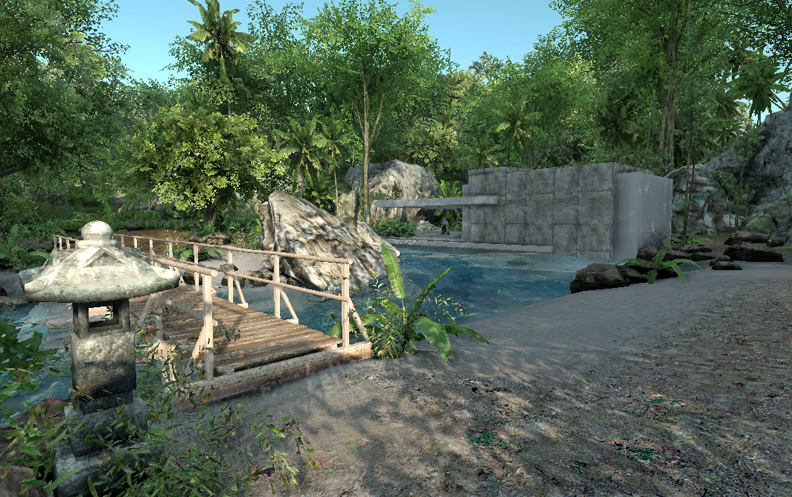
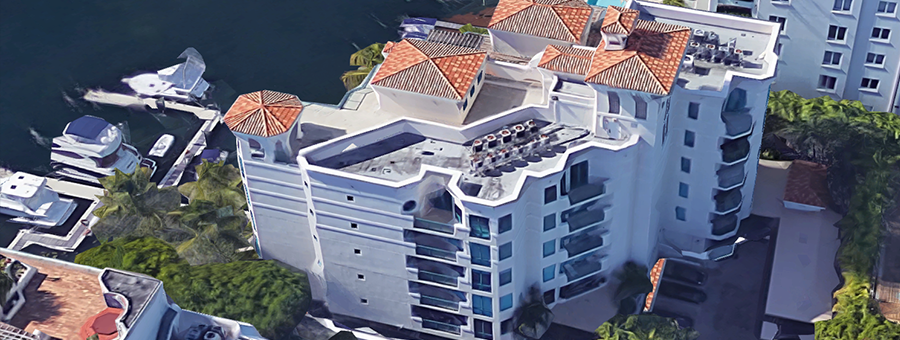
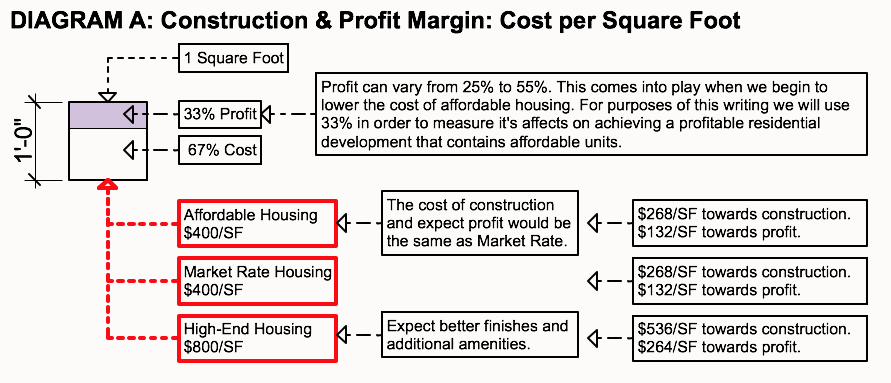
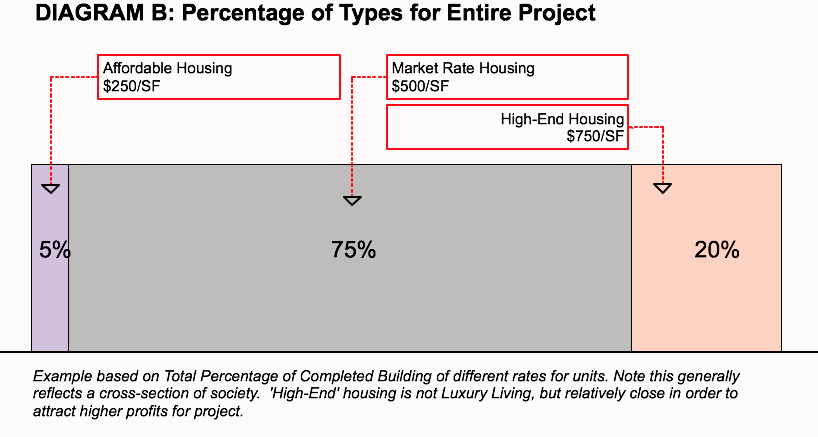
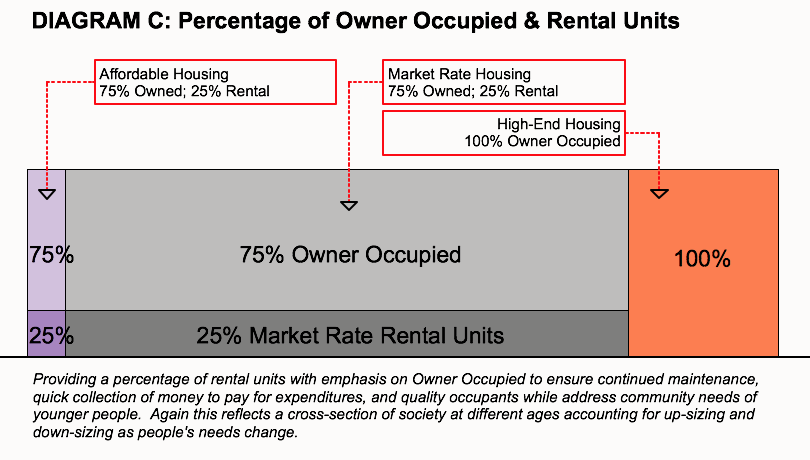
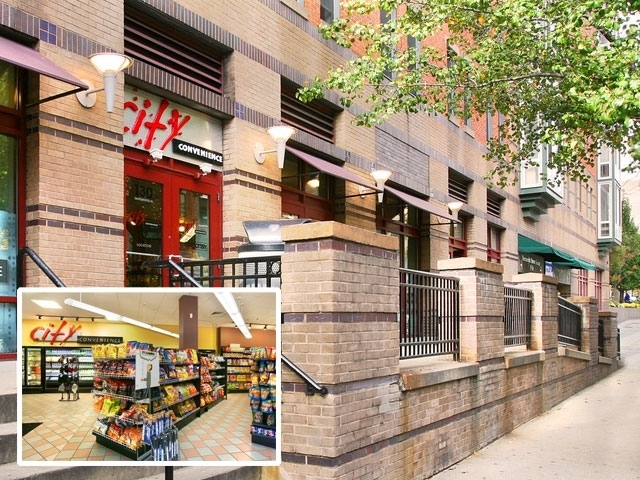
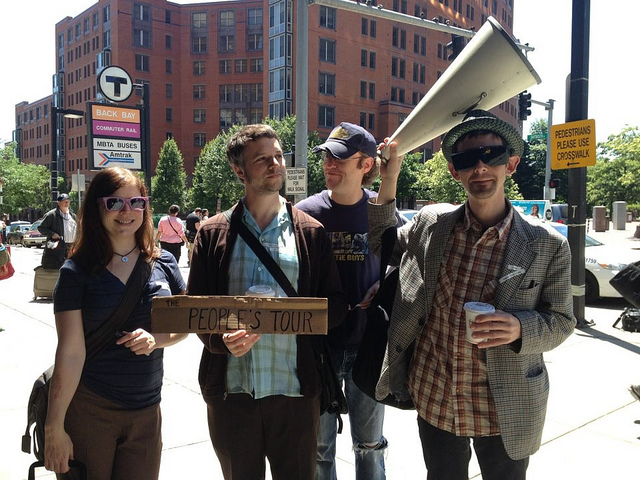
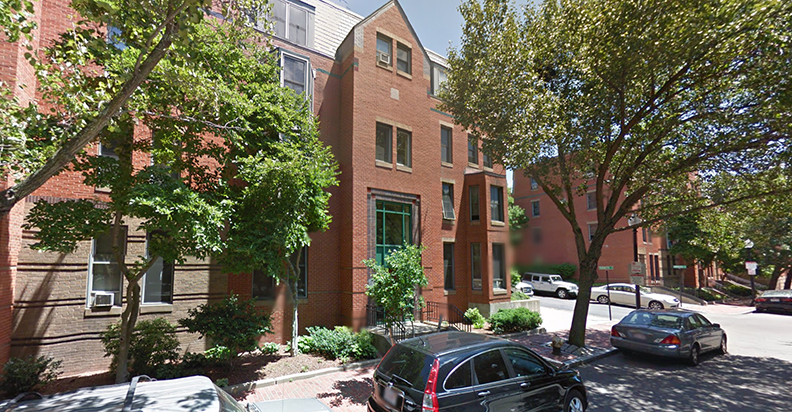
All projects on our website and blog were worked on or fully designed by SimpleTwig, like Tent City in Boston while working for Goody Clancy Associates.